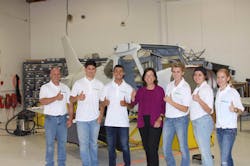How to Build General and Business Aviation’s Future Workforce
Summer is one of my favorite times of the year, because it means I join the winners of the annual GAMA Aviation Design Challenge to build an airplane. Now in its fifth year, we created this Challenge with our friends at Build A Plane to promote science, technology, engineering, and mathematics (STEM) skills in U.S. high schools. Building the future workforce for general and business aviation has never been more important, and GAMA is dedicated to ensuring we set our industry and future generations up for success.
This year, 93 high schools from 31 states and Washington, D.C., registered to enter the Challenge, an 18 percent increase from participation in 2016. We sent the schools free “Fly to Learn” curricula and software, powered by X-Plane, to learn about topics such as the four forces of flight, center of gravity and aspect ratio. After familiarizing themselves with the software, the teams -- one per high school comprised of four students, of which at least one must be female -- modified and flew a virtual Cessna 172SP. GAMA engineers evaluated and scored the submissions of the simulated flights based on the requirements of a maximum payload delivered as quickly and efficiently as possible. The teams also submitted an airplane modifications summary, a demonstration flight checklist, and three videos throughout the competition explaining what they learned at different stages.
Given the coursework required as part of the Challenge, all the students who enter the competition increase their knowledge of STEM and aviation. But the winners get the once-in-a lifetime experience of building a Glasair Sportsman. The winning team of this year’s Challenge was from Olney High School in Olney, TX. It was the first winning team to include two girls. At the end of June, I joined students Amber McCutcheon, Kodee Scott, Michael Gomez, and Bryant Castro, and their teacher Sabrina Laurent, at Glasair Aviation in Arlington, WA, and watched them put the skills they learned from the curriculum to use. Each year, it is immensely rewarding to witness these students build not only a plane, but also their skill sets, see their fascination with aviation grow and, for some, have it turn into a career in the industry.
I mentioned earlier in this piece that building the future workforce for our industry has never been more important. Thanks to studies conducted by Deloitte and The Manufacturing Institute in 2005, 2011, and 2015, we know there is a skills gap in the U.S. manufacturing sector, and that part of the problem is a lack of STEM skills among workers. While this is clearly not a new issue, it is an important one. The good news is that many in our industry and in the education sector recognize this, and have created programs or invested in aerospace education. GAMA is committed to being part of the solution through our Aviation Design Challenge, as are our member companies, who generously support the program each year and value this initiative so highly they’ve sent executive teams to see the build and talk with the students. We have also signed on as an endorser of National Manufacturing Day, which will take place on October 6 this year, and encourage you to participate too.
As the new school year begins, I’m proud to write that we have opened registration for the 2018 Aviation Design Challenge and have expanded our capacity for schools to register to 110! We hope AMT readers will recommend the Challenge to U.S. high school teachers, students, and parents. They can learn more about it and register to enter by visiting the “Opportunities in GA” section of www.gama.aero.
About the Author

Pete Bunce
Pete Bunce is the president and CEO of GAMA, an international trade association representing more than 100 of the world’s leading manufacturers of general aviation airplanes and rotorcraft, engines, avionics, components and related services. GAMA’s members also operate repair stations, fixed based operations, pilot and maintenance training facilities and they manage fleets of aircraft. You can read more about GAMA’s activities on our Web site at www.gama.aero and on our Facebook page at https://www.facebook.com/#!/General.Aviation.Manufacturers.Association.
